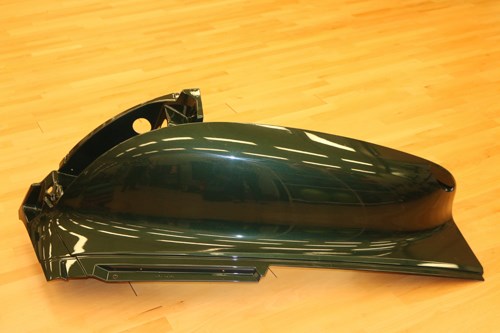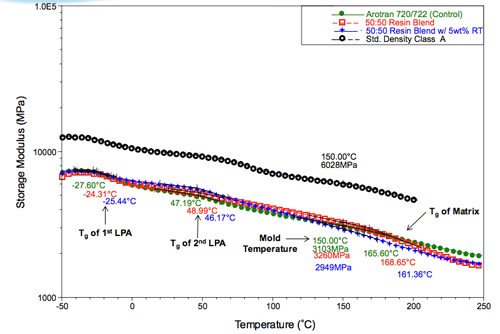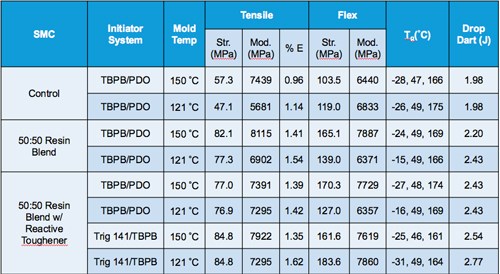Ashland unveils low-density, high-performance SMC
Ashland's new Arotran 771 sheet molding compound (SMC) offers a specific gravity of 1.2, with good mechanical and physical properties. The company is targeting 1.0 specific gravity, which would put SMC on par with aluminum in automotive applications.

Ashland, to assess the performance of its new 1.2 specific gravity Arotran 771 SMC, fabricated an automotive panel to Ford Motor Co. specifications and then tested it for E-coat tolerance. The material showed no blistering, which is seen as key to winning a place on production cars and trucks.
Michael J. Sumner, group leader – gelcoat, SMC, marine resin, Ashland Performance Materials (Columbus, OH, US), reported at SPE’s Thermoset Topcon (April 19-20) on the development of Arotran 771, the company’s newest sheet molding compound (SMC), designed specifically for use in automotive applications. Prompted by customer demand for a tough, low-density, E-coat-capable, cost-effective SMC, Arotran 771 offers a specific gravity of 1.2, along with some impressive physical and mechanical properties.
Sumner walked attendees through the SMC’s development, with particular emphasis on the evaluation of resin performance. Ashland looked at various combinations of vinyl ester and unsaturated polyester resin (UPR), testing for finished part surface quality, mechanical performance, Tg and E-coat tolerance.

Tg of Ashland's new Arotran 771 SMC (50:50 blend, with 5 wt% resin toughener in legend). The material offers a specific gravity of 1.2, with good strength and toughness, along with the ability to tolerate the E-coat process.
Initial tests of surface quality, as measured by advanced laser surface analyzer (ALSA), showed that a 50:50 blend of vinyl ester and UPR was optimal, with an ALSA value of 64. Ashland added a 5 wt% reactive toughener to the mix and got very good mechanical values: tensile strength 85 MPa, tensile modulus 8,600 MPa, flex strength 182 MPa, flex modulus 8200 MPa and elongation 1.41%. Drop dart impact resistance is 3.1J.
Further testing, Sumner says, revealed that the selection of initiator system and mold temperature can influence part quality. Ashland conducted a series of tests, combining different initiators with mold temperatures of 121°C or 150°C and evaluated surface quality and mechanical properties. The best-performing combination included the reactive toughener and a mold temperature in the 121-150°C range (see table).

Mechanical properties of Arotran 771 SMC (50:50 blend with toughener) compared to
non-toughener and standard SMC at two mold temperatures, with different initiators.
To assess E-coat performance, Sumner says Ashland fabricated several SMC panels to a Ford Motor Co. specification and ran them through the Ford E-coat test protocol, involving exposure to 38°C/100°F and 100% humidity for 10 days, followed by short-term exposure to 200°C/392°F heat. The panels showed absorption of 2.25% with no blistering, the latter of which is required to pass the test.
Arotran 771 represents a substantial increase in SMC performance, comparable to the TCA Ultra Lite brand SMC — also 1.2 specific gravity — introduced in 2015 by Continental Structural Plastics (CSP, Auburn Hills, MI, US). Sumner says Ashland is trialing Arotran 771 with several customers involved in the automotive supply chain.
In the meantime, Ashland is not standing pat. Sumner reports that the company is already working on chemistries to help push SMC specific gravity down to 1.1 and, eventually, 1.0. And those products could come on the market relatively soon. “If we can get to 1.0,” Sumner asserts. “We can effectively compete with aluminum.”
Related Content
The state of recycled carbon fiber
As the need for carbon fiber rises, can recycling fill the gap?
Read MoreMaterials & Processes: Resin matrices for composites
The matrix binds the fiber reinforcement, gives the composite component its shape and determines its surface quality. A composite matrix may be a polymer, ceramic, metal or carbon. Here’s a guide to selection.
Read MoreThermoplastic composites welding advances for more sustainable airframes
Multiple demonstrators help various welding technologies approach TRL 6 in the quest for lighter weight, lower cost.
Read MorePEEK vs. PEKK vs. PAEK and continuous compression molding
Suppliers of thermoplastics and carbon fiber chime in regarding PEEK vs. PEKK, and now PAEK, as well as in-situ consolidation — the supply chain for thermoplastic tape composites continues to evolve.
Read MoreRead Next
From the CW Archives: The tale of the thermoplastic cryotank
In 2006, guest columnist Bob Hartunian related the story of his efforts two decades prior, while at McDonnell Douglas, to develop a thermoplastic composite crytank for hydrogen storage. He learned a lot of lessons.
Read MoreComposites end markets: Energy (2024)
Composites are used widely in oil/gas, wind and other renewable energy applications. Despite market challenges, growth potential and innovation for composites continue.
Read MoreCW’s 2024 Top Shops survey offers new approach to benchmarking
Respondents that complete the survey by April 30, 2024, have the chance to be recognized as an honoree.
Read More


























